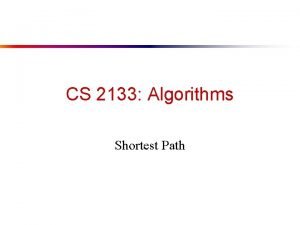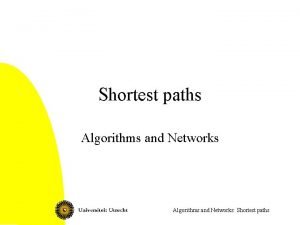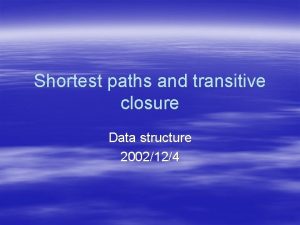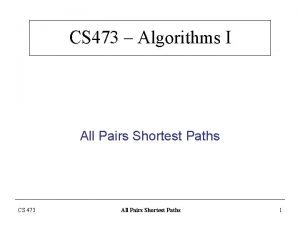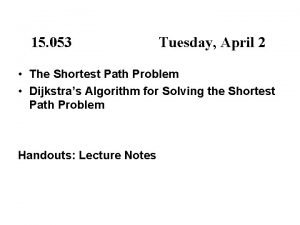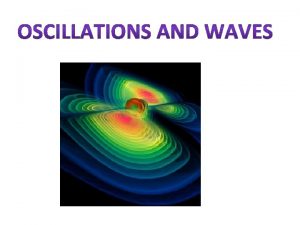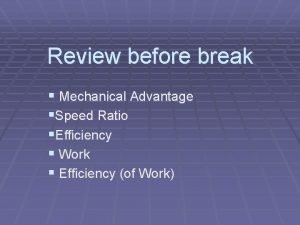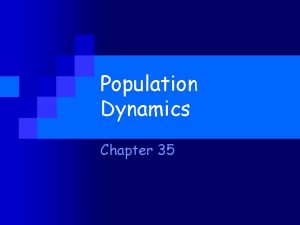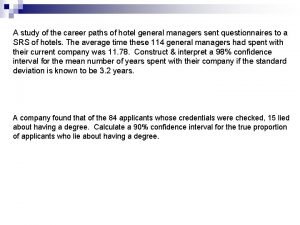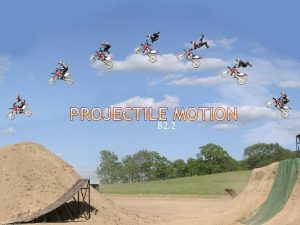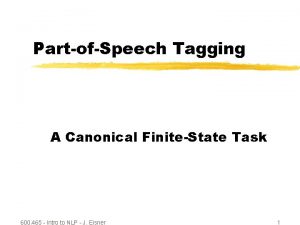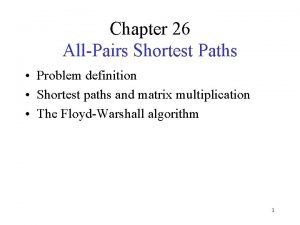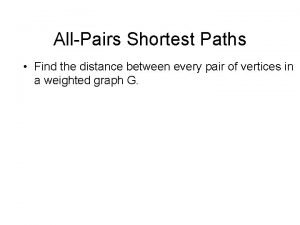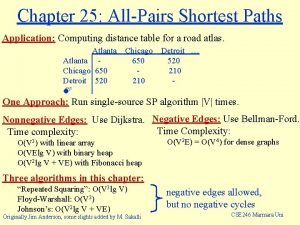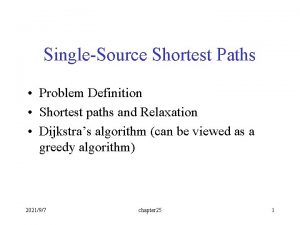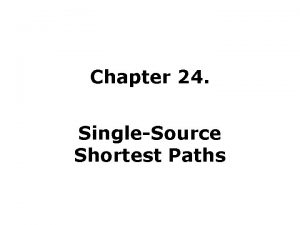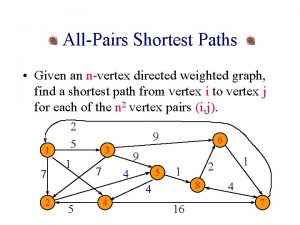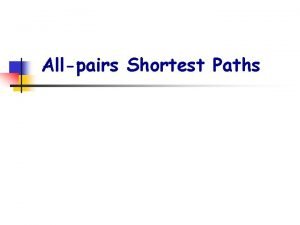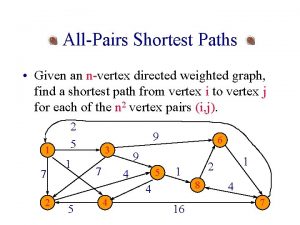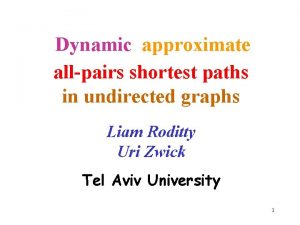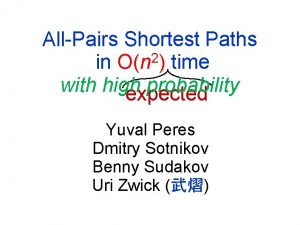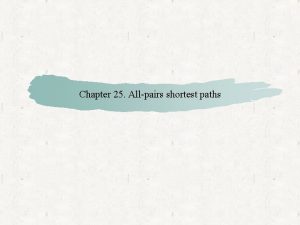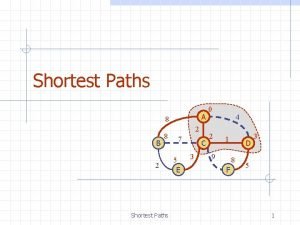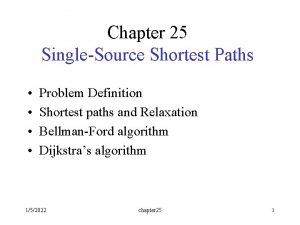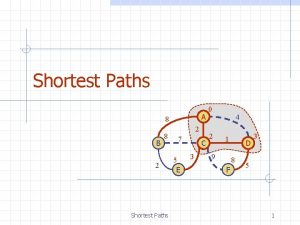Allpairs distance Relation with allpairs shortest paths Nave

































- Slides: 33


All-pairs distance �Relation with all-pairs shortest paths �Naïve algorithms from shortest-path tree �General weight: O(mn 2). �Non-negative weight: O(mn + n 2 log n). �Dynamic-programming �O(n 3 log n) �O(n 3): Floyd-Warshall �Reweighting �O(mn + n 2 log n): Johnson. 2

The settings 3 2 2 1 1 3 -3 1 2 3

The problem �Input: �An n-node m-edge directed graph G with edge length w. �Output: �The distance matrix d, where d(i, j) stands for the length of a shortest path from node i to node j. 4

Example 1 3 2 2 2 3 1 1 3 -3 4 5 1 6 2 input output d 1 2 3 4 5 6 1 0 3 2 3 0 2 2 ∞ 0 2 1 -2 0 3 ∞ ∞ 0 1 -2 0 4 ∞ ∞ ∞ 0 -3 -1 5 ∞ ∞ 0 2 6 ∞ ∞ ∞ 0 5

Distance & shortest path trees d 1 2 3 4 5 6 1 0 3 2 3 0 2 2 ∞ 0 2 1 -2 0 3 ∞ ∞ 0 1 -2 0 4 ∞ ∞ ∞ 0 -3 -1 5 ∞ ∞ 0 2 6 ∞ ∞ ∞ 0 1 3 2 2 2 3 1 1 3 -3 4 5 1 6 2 6

Focusing on distance 7

Recap: single source 8

Naïve algorithm: general w 9

Today’s objective Two ways to speed up the naïve algorithm for general w 10

Preprocessing �We first run Bellman-Ford in O(mn) time to rule out graphs with negative cycles. negat ive �We also ensure w(i, i) = 0 holds for each i. 11

Two techniques �Dynamic programming �Reweighting 12

Dynamic programming 13

i j 14

Recurrence relation i t j 15


17

Robert W. Floyd, 1936 -2001 �Born in New York, Floyd finished school at age 14. At the University of Chicago, he received a Bachelor's degree in liberal arts in 1953 (when still only 17) and a second Bachelor's degree in physics in 1958. �Becoming a computer operator in the early 1960 s, he began publishing many noteworthy papers and was appointed an associate professor at Carnegie Mellon University by the time he was 27 and became a full professor at Stanford University six years later. He obtained this position without a Ph. D. �Turing Award, 1978. 18

Stephen Warshall � 1935 – 2006 �Proving the correctness of the transitive closure algorithm for boolean circuit. � (Wikipedia) There is an interesting anecdote about his proof that the transitive closure algorithm, now known as Warshall's algorithm, is correct. He and a colleague at Technical Operations bet a bottle of rum on who first could determine whether this algorithm always works. Warshall came up with his proof overnight, winning the bet and the rum, which he shared with the loser of the bet. Because Warshall did not like sitting at a desk, he did much of his creative work in unconventional places such as on a sailboat in the Indian Ocean or in a Greek lemon orchard. 19

i j 20

Recurrence relation i k+1 j 21

Floyd-Warshall: O(n 3) time w 1 2 3 4 5 6 d 1 2` 3 4 5 6 1 0 3 2 ∞ ∞ ∞ 1 0 3 2 3 0 2 2 ∞ 0 2 1 ∞ ∞ 2 ∞ 0 2 1 -2 0 3 ∞ ∞ 0 1 -2 0 4 ∞ ∞ ∞ 0 -3 1 4 ∞ ∞ ∞ 0 -3 -1 5 ∞ ∞ ∞ ∞ 0 2 6 ∞ ∞ ∞ ∞ ∞ 0 22

Reweighting 23

Naïve algorithm: nonnegative w 24

Donald B. Johnson 25

The idea of reweighting 26

Illustration 2 1 8 5 4 4 3 2 -1 2 4 4 3 2 7 6 11 10 7 11 3 27

The challenge 28

Johnson’s technique 29

Illustration 0 3 2 2 0 0 1 1 3 -3 0 -3 1 -1 2 30

Non-negativity? 0 i j 31

Johnson’s algorithm 32

Summary �Using Johnson’s reweighting technique, the problem of computing all-pairs shortest paths for general w can be reduced to that for non-negative w. 33
 All-pairs shortest paths
All-pairs shortest paths Undirected
Undirected Shortest path problem linear programming
Shortest path problem linear programming Single-source shortest paths
Single-source shortest paths Difference constraints and shortest paths
Difference constraints and shortest paths Shortest paths and transitive closure in data structure
Shortest paths and transitive closure in data structure Sssp
Sssp Algorithm definition
Algorithm definition Skew lines
Skew lines Smile is the shortest distance between two hearts
Smile is the shortest distance between two hearts Minimum cost flow
Minimum cost flow The shortest distance between two points
The shortest distance between two points The ratio of input distance to output distance
The ratio of input distance to output distance What is the difference between distance and displacement
What is the difference between distance and displacement Wave winding parallel paths
Wave winding parallel paths Sherry hamby
Sherry hamby Energy paths
Energy paths Eulerian paths
Eulerian paths Flor control doz
Flor control doz Seeking the old paths
Seeking the old paths A study of the career paths of hotel general managers
A study of the career paths of hotel general managers Dd path graph for triangle problem
Dd path graph for triangle problem Load paths
Load paths Double data hazard
Double data hazard Networks and graphs: circuits, paths, and graph structures
Networks and graphs: circuits, paths, and graph structures List of careers in horticulture
List of careers in horticulture Human migration out of africa
Human migration out of africa Buddhist eightfold path
Buddhist eightfold path Paths, trees, and flowers
Paths, trees, and flowers Yes there are two paths
Yes there are two paths Six paths framework
Six paths framework Parabolic paths
Parabolic paths Paths start and stop at
Paths start and stop at Linearly independent paths
Linearly independent paths



